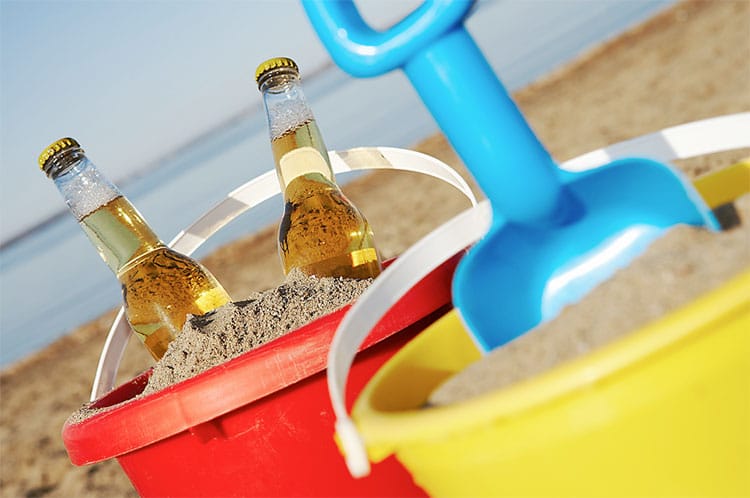• by Carri L. Wroblewski, BRIX Wine Shop •
I admit—I don’t drink a lot of beer. But there are those moments when any other beverage just doesn’t fit the bill. For instance, a friend of mine on island loves a beer after his 6-mile runs. Makes sense. When I lived in D.C. and ran through the streets of Georgetown with the running group Hash House Harriers, our unconventional mid mile stops were not for water, but rather beer. So, I understand my friend Peter’s desire to quench his post workout thirst with a cold one.
Then there are certain foods that only beer teams up with perfectly. Like the hot dog. Last spring while we were preparing to open our wine shop with no time to cook and less time to eat, we often popped over to Lola Burger. Though the cheeseburgers are delicious, for me it was the wagyu beef hot dog that stole the show. And the only thing better than upgrading to the truffle fries is the beer that I washed it all down with.
Perusing their beverage list my eyes stopped on an unfamiliar libation. Hell or High Watermelon? I had to ask. After a brief description it only made me want it more. Just to be sure I confirmed that it was on draft—typically the only way I drink it. Disappointingly the server told me it only came in a can. Now when I think of canned beer, memories of drinking “Natty Light” in an Indiana cornfield come to mind, so I hesitated, but agreed. Out came this flashy can illustrated with a cartooned Lady Liberty sitting on top of the Golden Gate Bridge. When did canned beer become so cool?
Back in fashion and better for the environment, I learned many of our favorite suds are saying goodbye to the bottle and hello to the can. First officially debuted in Richmond, VA in 1935 by The Gottfried Krueger Brewing Company, canned beer has had a storied past. Its initial entry into the market didn’t come until after Prohibition ended. American Can (the company making the can) had to overcome two major obstacles before they could sell the idea to the big brewers. First, they had to make a can that could withstand the pressure of beer, and second, they had to find a material to line the inside of the can so it wouldn’t react with its contents. A trial run with Pabst proved positive, but the company still wasn’t sold on the idea and wouldn’t commit until tested in a real market. Enter Krueger’s.
A small brewery based in Newark, New Jersey, Krueger’s business suffered during Prohibition. To make the “can idea” appealing to them, American Can offered to foot the bill for the canning line and the first test run. Just 2,000 initial cans were produced and dropped at homes around Richmond, VA with a questionnaire on quality. The response was overwhelming. Kreuger went full speed ahead and the beer can was born.
But back to that cornfield in Indiana—historically when we think of canned beer we think of beers from bigger breweries like Anheuser Busch and Heineken. And truthfully, many of us think of those beers as being lesser quality. So when did the little guys, the craft breweries get into the game and why?
According to the ‘Cantastic Database,’ there are 410 craft breweries and over 1,450 craft canned beers now on the market. And the argument for ‘canning it’ is growing. On the scientific side, cans protect beer from light and oxygen, both of which can destroy a beer’s freshness. Bottled beers exposed to too much light can become ‘skunky’ and undrinkable. The same goes for oxygen. If even a little seeps under the bottle cap, your beers been compromised.
But for practical reasons how does the can stack up next to its bottled counterpart? On Nantucket the can is a natural. Toss a six-pack into your bag and head to the beach. With a six-pack of cans, you’ve lightened the load. And once you’re there, a can’s time in the cooler is less due to its ability to chill faster. For those of you pouring poolside, the “No Glass Allowed” sign is a simple reminder of why the can is king. Heading off to Madaket? With a recycling regiment as serious as we have on island, the environmental angle has its advantages too. An aluminum can is very easy to recycle and can be melted down over and over again, never losing its quality.
Even the island’s own Cisco Brewers is now offering in cans their classics: Whales’ Tale Pale Ale, IPA, Sankaty Light, and Summer.
So what summer suds should you be sipping? Uinta Brewing Company based in Utah makes a refreshing IPA in cans called Hop Nosh. Dressed in an eye-catching yellow six-pack box, it’s loaded with hops and has bold flavors of citrus and malt.
Oskar Blues ‘Dale’s Pale Ale’ was a trailblazer when it comes to the can. Launching its canning operations in 2002, it was the first craft-canned mountain ale. A flavorful beer crafted with substantial amounts of European malts and four kinds of American hops, there’s a lot to love in these 12 ounces.
And 21st Amendment Brewery, who kicked off the craft can craze for me, makes a session ale (a low alcohol beer) called Bitter American. Without sacrificing flavor this is a beer you can take to the beach and drink all day long. But they really nailed it with their wheat beer Hell or High Watermelon. Light, refreshing, with a whisper of watermelon flavor, they canned a little bit of summer.
There’s something throw-back about the can, something special when you crack open that top, hear the gentle release, and take that first, thirst quenching sip.



